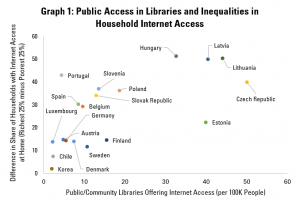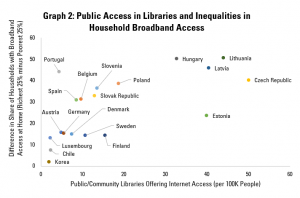The Internet Governance Forum has continued this week, taking place, for the first time, in virtual format. With a focus on inclusion and resilience, it has been an opportunity to emphasise the need for action to allow everyone to connect, meaningfully, to the internet.
Last week’s Library Stat of the Week started to look at the data around the numbers of households not just connected to the internet, but also who enjoy adequate speeds (broadband), and have the devices necessary to make use of it.
The data presented underlined that in a number of countries, a large share of those officially connected did not enjoy sufficient speeds or have the equipment needed – in other words, a second class type of access.
In particular, it also highlighted that these issues were more commonly experienced by those living in poorer households, compared to richer neighbours.
This week’s post looks further at these questions of inequality, and how they compare with numbers of libraries offering internet access possibilities. The data used comes from the Organisation for Economic Cooperation and Development’s data on household internet access, and IFLA’s own Library Map of the World data on public and community libraries offering internet access.
Through this, we can start to think about the potential of libraries to help people who may be at risk of having only a ‘second-class’ internet access, or none at all.

Graph 1 starts by looking at the number of public and community libraries per 100 000 people offering internet access, and the gap in household internet access rates between the richest and poorest 25% of the population.
Each dot represents a country, and is labelled. The further to the right the dot is, the more libraries there are offering access, while the further up it is, the higher the gap in household internet access rates between the richest and poorest.
The Czech Republic, Hungary, Latvia and Lithuania, we can see, have both high numbers of libraries offering access, and high inequalities in household access. In general, across the countries for which data is available, where gaps are higher, there are more libraries.
This is encouraging, indicating that libraries can be well placed to address the access gaps experienced by people in less well-off households.

Graph 2 repeats the exercise, but for broadband – i.e. higher speed internet that opens up different possibilities for meaningful connectivity. The picture is similar overall, although it is possible to see that in some countries, relative inequalities are greater when it comes to broadband than when it comes to basic internet access.

Graph 3 looks instead at household computer access. As set out last week, many uses of the internet require computers – preparing CVs, using different programmes and services, or other tools.
This shows countries in different positions relative to each other, notably with countries like Slovenia, Korea and Spain having relatively high levels of inequality when it comes to computer access related to overall incomes.
Nonetheless, the overall trend among countries still holds that in those countries where inequality in household computer access is highest, there are more libraries ready to provide an alternative.
As IFLA is arguing at the Internet Governance Forum, libraries form a vital part of the connectivity infrastructure, including the possibility of access at an adequate speed, and with the possibility to use devices that may not be available from home.
From this week’s library stat of the week, it seems clear that often in the countries that need this alternative the most, in order to avoid those on lower incomes being stuck with second-class internet, libraries are available to help.
Find out more on the Library Map of the World, where you can download key library data in order to carry out your own analysis! See our other Library Stats of the Week! We are happy to share the data that supported this analysis on request.